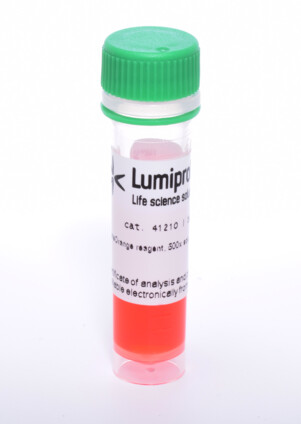LUCS® 13, green fluorescent nucleic acid stain
| 目录号 | 数量 | 价格 | 提前通知时间 | 购买此产品 |
|---|---|---|---|---|
| 14010 | 50 uL, 5 mM/DMSO |
$110
|
现货 | |
| 24010 | 250 uL, 5 mM/DMSO |
$250
|
现货 | |
| 44010 | 1 mL, 5 mM/DMSO |
$750
|
现货 |

LUCS 13 is a cell-permeant nucleic acid stain that exhibits green fluorescence upon binding to nucleic acids. The stain has a high fluorescent yield and a structure identical to SYTO™13 stain.
LUCS 13 is used to stain both DNA and RNA in live and dead eukaryotic cells as well as Gram-positive and Gram-negative bacteria. The dye is excited by the blue laser at 488 nm. Its fluorescence emission is detected in the fluorescein channel with a peak at 509 nm when bound to DNA and 514 nm when bound to RNA.
The dye can be used in simultaneous labeling with cell-impermeant nuclear markers, such as YoDi-3, to evaluate cell viability using fluorescence microscopy and flow cytometry.

顾客还购买了这个产品
General properties
| Appearance: | orange solution |
| Solubility: | miscible with water |
| Storage conditions: | Storage: 24 months after receival at -20°C in the dark. Transportation: at room temperature for up to 3 weeks. Avoid prolonged exposure to light. Desiccate. |
| 安全数据表(MSDS): | 下载 |
| 产品规格 |
Spectral properties
| Excitation/absorption maximum, nm: | 488 |
| Emission maximum, nm: | 509 (DNA complex), 514 (RNA complex) |
产品引用
- Suwatthanarak, T.; Tanjak, P.; Chaiboonchoe, A.; Acharayothin, O.; Thanormjit, K.; Chanthercrob, J.; Suwatthanarak, T.; Niyomchan, A.; Tanaka, M.; Okochi, M.; Pongpaibul, A.; Chalermwai, W.V.; Trakarnsanga, A.; Methasate, A.; Pithukpakorn, M.; Chinswangwatanakul, V. Overexpression of TSPAN8 in consensus molecular subtype 3 colorectal cancer. Experimental and molecular pathology, 2024, 137, 104911. doi: 10.1016/j.yexmp.2024.104911



























 $
$ 
